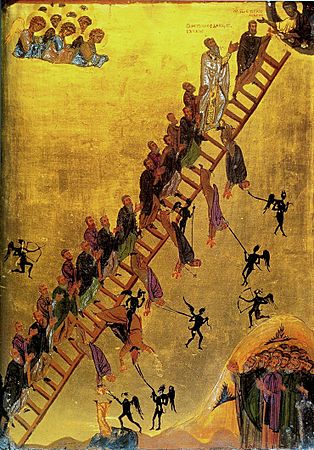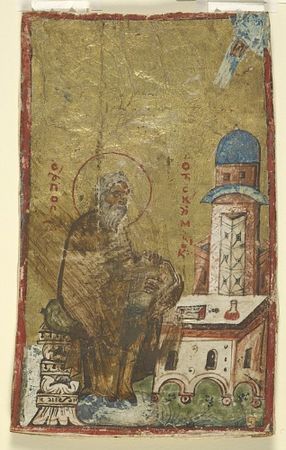John Climacus facts for kids
Quick facts for kids SaintJohn Climacus |
|
|---|---|

Thirteenth century icon of St. John Climacus; to either side are Saint George and Saint Blaise (Novgorod School)
|
|
| Born | c. 579 Syria |
| Died | March 649 (aged 69–70) Mount Sinai |
| Venerated in | Roman Catholic Church Orthodox Catholic Church |
| Feast | 30 March, Fourth Sunday of Great Lent |
| Attributes | Clothed as a monk, sometimes with an Abbot's paterissa (crozier), sometimes holding a copy of his Ladder |
John Climacus (Greek: Ἰωάννης τῆς Κλίμακος; Latin: Ioannes Climacus) was an important Christian monk who lived a long time ago. He is also known as John of the Ladder, John Scholasticus, and John Sinaites. He lived at a monastery on Mount Sinai in the 6th and 7th centuries. Both the Orthodox Catholic Church and the Roman Catholic Church honor him as a saint.
Contents
The Life of Saint John Climacus
We don't have a lot of information about John Climacus's early life. An old biography, called a vita, was written by a monk named Daniel. Daniel said he knew John, but he didn't know where John was born. Most details about John's birth come from much later stories.
For a long time, people thought John lived in the late 500s. But newer studies suggest he lived in the 600s instead. If Daniel's story is true, John became a novice (a beginner monk) at the Vatos Monastery on Mount Sinai when he was about 16 years old. This monastery is now known as Saint Catherine's Monastery. An older monk named Martyrius taught him about spiritual life.
John's Time as a Hermit
After Martyrius died, John wanted to live a very strict spiritual life. He moved to a hermitage, which is a quiet place for one person, at the bottom of the mountain. He lived there alone for about twenty years. During this time, he studied the lives of other saints. This made him one of the most knowledgeable Church Fathers.
However, some recent discoveries suggest a different story. These findings show that John's writings use clever language and deep philosophical ideas. This means he likely had a good education, perhaps for a job in law or government. He probably got this training somewhere else, not in Sinai.
It seems John might have lived by the sea, possibly in Gaza, and worked as a lawyer. He may have joined the Sinai Monastery only after his wife died, when he was in his early forties. This idea helps explain the wide knowledge and high quality of his writings, which clearly show a strong philosophical background. The older story about him becoming a monk at 16 might have been created to make him seem like he wasn't influenced by worldly education.
Becoming an Abbot
When John was about 65 years old, the other monks at Sinai asked him to become their hegumen, or abbot (the head of the monastery). He led the monastery with great wisdom. His fame grew so much that, according to his biography, Pope Gregory the Great even wrote to him. The Pope asked John to pray for him and sent money for the hospital at Sinai, where pilgrims stayed.
The Ladder of Divine Ascent
John Climacus wrote two main books. The most famous is called Κλῖμαξ (Scala Paradisi in Latin), which means The Ladder of Divine Ascent. He wrote it in the early 600s because John, the Abbot of Raithu Monastery, asked him to. He also wrote a shorter book called To the Pastor, which is like an extra part for the Ladder. In the Ladder, John talks about how monks should carry a small notebook to write down their thoughts during prayer.
What the Ladder Teaches
The Ladder teaches people how to bring their soul and body closer to God. It explains how to gain good qualities through a disciplined spiritual life. John Climacus uses the idea of Jacob's Ladder from the Bible as a way to organize his teachings. Each chapter is called a "step." There are thirty steps, which matches the age of Jesus when he was baptized and began his work.
The book has three main parts:
- The first seven steps talk about general good qualities needed for a spiritual life.
- The next nineteen steps (Steps 8–26) teach how to overcome bad habits and build good ones.
- The last four steps focus on higher virtues, like prayer, stillness, and peace of mind. The very top step of the ladder is love.
Importance of the Ladder
The Ladder was first written for monks in a nearby monastery. But it quickly became one of the most popular and loved books about spirituality in the Byzantine Empire. Today, it is still widely read by Orthodox Christians, especially during Great Lent, the time before Pascha (Easter).
In Orthodox monasteries, the Ladder is often read aloud in the trapeza (dining hall). In some churches, it is read during daily services on weekdays during Lent.
The Ladder of Divine Ascent Icon
There is a famous icon (a religious painting) also called Ladder of Divine Ascent. It shows a ladder reaching from Earth all the way to Heaven. Several monks are shown climbing the ladder. At the very top, Jesus is waiting to welcome them into Heaven.
The icon also shows angels helping the climbers. But it also shows demons trying to pull the climbers down or shoot them with arrows, no matter how high they have climbed. Most versions of the icon show at least one person falling off the ladder. Often, in the bottom right corner, Saint John Climacus himself is shown. He is pointing to the ladder, with rows of monks behind him.
Feast Day and Legacy
Saint John's feast day is celebrated on March 30 in both Eastern and Western Christian churches. The Eastern Orthodox Church and Byzantine Catholic churches also remember him on the Fourth Sunday of Great Lent. Many churches in Russia are named after him, including a church and belltower in the Moscow Kremlin. John Climacus was sometimes called "Scholasticus," but he is not the same person as John Scholasticus, who was a Patriarch of Constantinople.
Several English translations of his works are available. One well-known translation was made by Holy Transfiguration Monastery (Boston, 1978). This book includes Daniel's Life of St. John, The Ladder of Divine Ascent, and To the Pastor. It also has notes that explain many of the ideas and words from an Orthodox point of view.
Images for kids
-
John Climacus is shown at the top of the Ladder of Divine Ascent icon, with other monks following him, 12th-century icon (Saint Catherine's Monastery, Mount Sinai, Egypt)
See also
 In Spanish: Juan Clímaco para niños
In Spanish: Juan Clímaco para niños
- Søren Kierkegaard, a philosopher who used the name "Johannes Climacus" as a pen name for some of his books.
- Saint John Climacus, patron saint archive
- The Uncondemning Monk; also remembered on March 30



